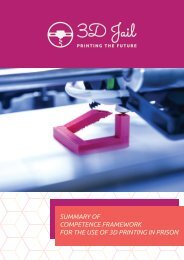3D Jail Project - IO1 - Competence framework for 3D printing in jail
Intellectual Output 1 The main innovative element of IO1 is to entail professionalizing competencies on the use of 3D printing technologies in the learning context of people with fewer opportunities because of their status of prisoners, ex-prisoners or subjected to alternative measures to detention. It is innovative because – in a pioneering way in Europe – it puts the basis to frame this kind of competencies in relation with restricted people, in the context of prison security, and it challenges penitentiary administrations to innovate their procedures and conditions to use even more ICT technologies inside their structures. It also poses prisons’ educational systems before the challenge to include these specific competencies in the educational experience of the inmates.
Intellectual Output 1 The main innovative element of IO1 is to entail professionalizing competencies on the use of 3D printing technologies in the learning context of people with fewer opportunities because of their status of prisoners, ex-prisoners or subjected to alternative measures to detention. It is innovative because – in a pioneering way in Europe – it puts the basis to frame this kind of competencies in relation with restricted people, in the context of prison security, and it challenges penitentiary administrations to innovate their procedures and conditions to use even more ICT technologies inside their structures. It also poses prisons’ educational systems before the challenge to include these specific competencies in the educational experience of the inmates.
- No tags were found...
Create successful ePaper yourself
Turn your PDF publications into a flip-book with our unique Google optimized e-Paper software.
There is an onl<strong>in</strong>e plat<strong>for</strong>m <strong>in</strong> Germany named “Elis” to which 11 prisons currently have<br />
access. Prisoners can access more than 330 learn<strong>in</strong>g environments and media on this<br />
plat<strong>for</strong>m. Elis enables prisoners to complete courses and consequently gett<strong>in</strong>g a degree or<br />
license (e.g. European Computer Driv<strong>in</strong>g License – ECDL). 4<br />
In Turkey, Anadolu University Open Education Faculty offers non-thesis master’s programs<br />
(fully onl<strong>in</strong>e programs) <strong>in</strong> which prisoners can get enrolled. Prisoners that complete these<br />
programs earn a master’s degree.<br />
In a nutshell, questionnaire data collected from project partners provide evidence that<br />
there are some regulations and practices regard<strong>in</strong>g the use of technologies such as<br />
2D/Digital-Graphic/Onl<strong>in</strong>e Media <strong>in</strong> prisons. The major f<strong>in</strong>d<strong>in</strong>gs po<strong>in</strong>t to the presence of<br />
modular tra<strong>in</strong><strong>in</strong>g programs and PC laboratories, almost full access to computers, use of<br />
computers and basic software, focus on 2D design content, delivery of tra<strong>in</strong><strong>in</strong>g programs <strong>in</strong><br />
distance mode and via e-learn<strong>in</strong>g, delivery of face-to-face tra<strong>in</strong><strong>in</strong>g programs, and<br />
certification offered upon completion of a program. The current software is usually only<br />
used locally and rarely has access to the Internet, or if it does, it is severely restricted.<br />
Exist<strong>in</strong>g cases of education projects <strong>in</strong> prisons<br />
The questionnaire further sought <strong>in</strong><strong>for</strong>mation on the content, methods and programs of<br />
tra<strong>in</strong><strong>in</strong>g opportunities <strong>for</strong> prisoners, and outcomes of relevant projects implemented <strong>in</strong><br />
prisons.<br />
The Italian team referred to “<strong>Project</strong> Cisco (Bollate)” and “<strong>Project</strong> <strong>for</strong> the realisation of a<br />
cabl<strong>in</strong>g course <strong>in</strong> the juvenile detention centre of Florence”. The aim of the <strong>Project</strong> Cisco<br />
was to improve prisoners’ basic computer skills. The project was based on e-learn<strong>in</strong>g,<br />
offered via www.netcad.com. The second project <strong>in</strong> Italy used both e-learn<strong>in</strong>g and face-toface<br />
learn<strong>in</strong>g to deliver tra<strong>in</strong><strong>in</strong>g programs.<br />
The projects reported by the Belgian team were “M_TIPE – Mentor<strong>in</strong>g Teachers <strong>in</strong> Prison<br />
Education”, “IN & OUT – Exchange of methodologies <strong>in</strong> education of deta<strong>in</strong>ees” and “Little<br />
stories, great hopes – Autobiography as an <strong>in</strong>strument <strong>for</strong> replann<strong>in</strong>g <strong>in</strong> consequence of an<br />
imprisonment experience”. With regard to the method of teach<strong>in</strong>g, it is important to<br />
highlight the “IN & OUT – Exchange of methodologies <strong>in</strong> education of deta<strong>in</strong>ees”, which may<br />
potentially be perceived as a best practice. The aim of the project is to <strong>in</strong>vestigate the<br />
organizational, philosophical and historical development of courses <strong>for</strong> <strong>in</strong>mates <strong>in</strong><br />
penitentiaries.<br />
4 M2C<br />
6





